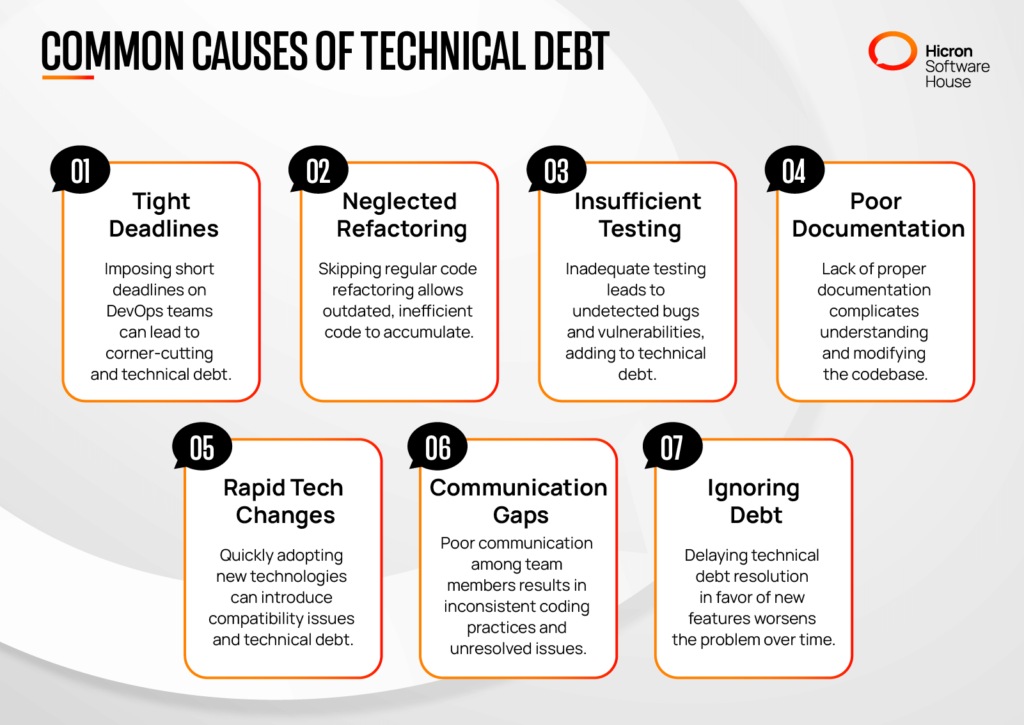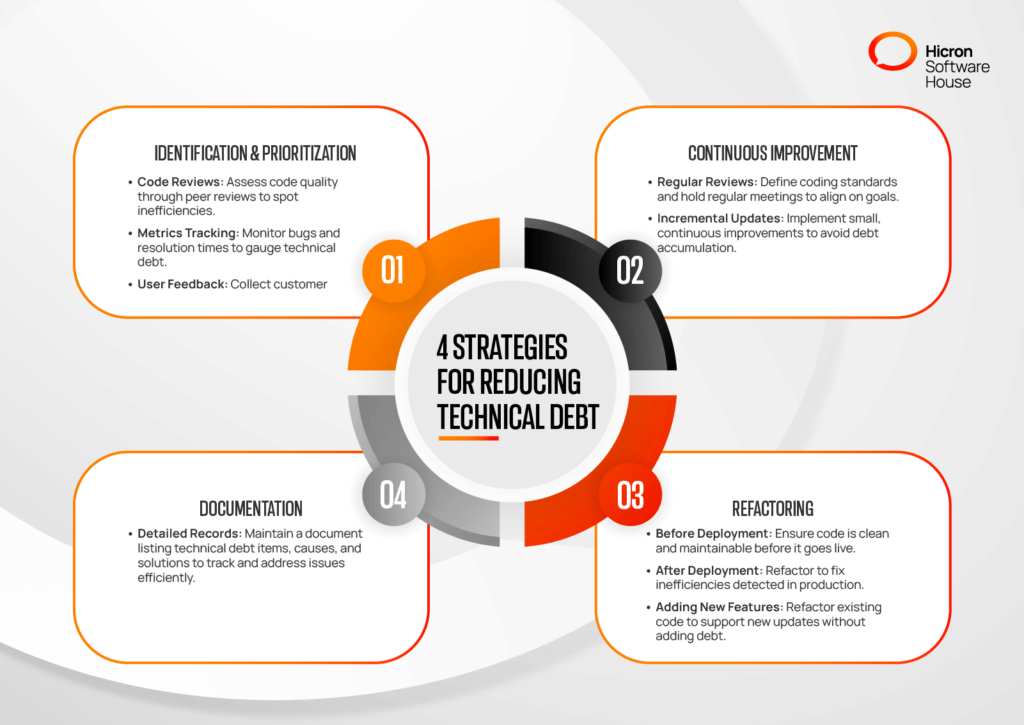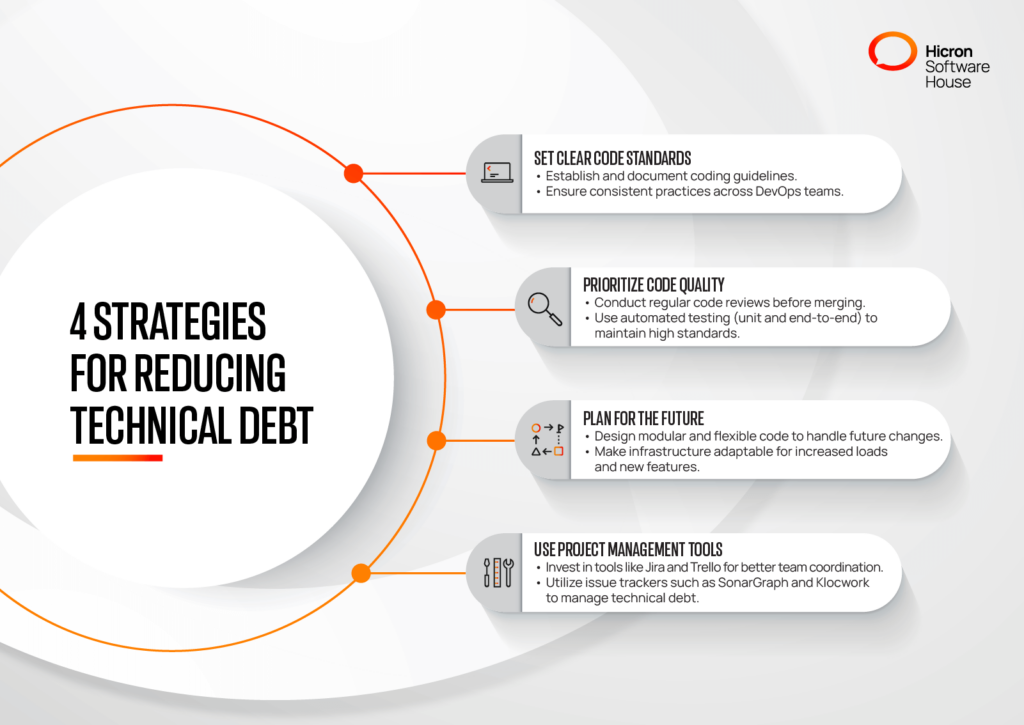How to Use DevOps for Digital Transformation
- April 21
- 4 min

Businesses face multiple challenges in ensuring smooth IT operations and technical debt is one of them. This type of debt severely damages your business productivity and efficiency.
A McKinsey Digital report also states that tech debt makes up 20 to 40 percent of the value of a business’s entire technology estate. This requires you to immediately adopt strategies to mitigate technical debt effectively and take your DevOps initiatives on the road to success.
Want to know more? Let’s discuss some strategies that help you in reducing technical debt in DevOps, paving the way for top-notch efficiency.
Typically, technical debt in DevOps refers to the gap between the software quality as promised and what is delivered to end users. In DevOps, technical debt arises when development teams opt for quick, inefficient solutions over high-quality implementations.

Common causes of technical debt include:
Despite your best efforts and the methodologies you choose, technical debt is an inevitable part of software development.
Various strategies help you reduce technical debt, such as early identification of issues and regular refactoring.

Let’s discuss them in detail:
First things first, you should start by identifying the technical debt in your codebase to understand its scope and impact on your projects. There are a few methods that help you in this, such as:
In addition to these methods, you can also employ technical debt ratios and tools like SonarQube and Coverity Track to determine the quality of your codes.
Once you’ve identified the issues in the code, you must categorize them into high-priority and low-priority categories. Make sure to tackle the high-priority issues first to ensure the code works smoothly and leads to a positive user experience.
Regular review and continuous improvement are necessary to ensure your code works efficiently without any technical debt. For instance, you should clearly define high-quality codes, including the coding standards, design and development, and performance criteria.
You should also organize regular meetings with all stakeholders and DevOps teams so everyone understands expectations and goals perfectly.
Once everything is clear, encourage your team to take small steps to refine and optimize the codebase continuously. This incremental handling and improvement of technical debt eliminates the risk of accumulation.
Another strategy that aids you in reducing technical debt is refactoring. Generally, refactoring means restructuring the codebase without making any changes to its exterior functionality. Regularly refactoring provides you with plenty of benefits, such as increasing the readability of code, efficient bug fixing, and, of course, no technical debt.
There are different times to refactor a code given as:
Before Deployment: You should first refactor the code before deployment to ensure that the code is clean, efficient, and maintainable before it goes live. This significantly reduces the risk of technical debt in your DevOps projects and makes future updates easier to implement.
After Deployment: It’s important to refactor the code after deployment to eradicate any inefficiencies not apparent during development. This will result in better code stability and performance in the production environment.
When Adding New Features: Before adding new features or bug fixes, you must refactor the whole codebase. This gives you an idea of whether the existing infrastructure is capable of handling new updates without accumulating technical debt.
Don’t forget to test the code thoroughly after refactoring to ensure it is clean and efficient so there’s no chance of any future problems!
Developers should properly document the technical debt to get an idea of the codebase. For instance, you can create a document listing all known technical debt items, their causes, and potential solutions.
This helps maintain and debug the code by providing clear insights into existing issues. But that’s not all.
Proper documentation also plays a critical role in helping new developers get on board quickly and understand the issues at hand, reducing the accumulation of technical debt.
Some DevOps practices that help you manage technical debt smoothly include promoting communication and collaboration among team members and introducing CI/CD in the development phase.
Here’s a detailed overview of these DevOps practices:
Communication and collaboration are key to enabling DevOps teams to collaborate on tasks, identify issues, and reduce overall technical debt. Therefore, you should create effective communication channels like team chat platforms, project management tools, and regular stand-up meetings.
This breaks down silos and creates a culture of transparency and teamwork. In addition, it ensures that all team members have a shared responsibility for the codebase and technical debt. Hence, it leads to more proactive identification and resolution of issues.
Another practice is to opt for continuous integration and continuous delivery (CI/CD). Continuous integration involves integrating code changes from multiple developers into one single codebase, while continuous delivery involves using automation to speed up the deployment of code to a production environment.
Together, CI and CD ensure that changes to a codebase are rigorously tested and automatically employed. This results in less risk of code integration issues, which ultimately means you’ll come across little to no debt accumulation.
When developers do most of the tasks like testing, configuration, and deployment manually, they may make errors that translate to increased technical debt. Therefore, another thing you should do is automate most of the software development tasks.
Automation reduces human error, ensures consistency, and speeds up processes. For instance, you can implement automated testing in the DevOps pipeline to enhance the reliability and quality of your code. This lessens technical debt and improves your organizational efficiency.
Many DevOps teams are unaware of this, but Infrastructure as Code (IaC) is also an incredible practice that helps mitigate and address technical debt. IaC is the management of your IT infrastructure using automatic code scripts instead of manual work.
It frees you from the hassle of building code changes from scratch, and you can simply reuse and modify existing scripts. Moreover, the version control in IaC enables tracking code changes and rolling back to previous versions if needed. This ensures consistency and reduces errors and discrepancies in different environments. See the case study.
Most times, your code fails, and you become a victim of technical debt due to a lack of DevOps monitoring and observability. Therefore, you should keep track of some key metrics like deployment frequency and deployment failure rate. This gives you an overview of what’s happening in your IT systems and applications, helping you identify any bottlenecks before they escalate into larger issues and improving system efficiency.
To save your business from resource exhaustion, you should make adequate efforts to prevent technical debt.

This involves proper planning and the usage of the right tools. Let’s discuss some tips in this regard:
Other than these tips, you should invest in project management tools like Jira and Trello to synchronize the efforts of your DevOps teams for better efficiency. You must also use issue tracker tools, including SonarGraph and Klocwork.
These tools can help analyze your codes with great precision and flag errors that may occur during testing. You can then take immediate steps to eradicate them, eliminating any chances of technical debt issues.
If you don’t handle the technical debt on time, it can put your business under immense pressure. You’ll have dissatisfied customers leaving negative reviews that will impact your hard-earned reputation. But not anymore. Hicron Software House takes all your coding-related issues away. We have a team of DevOps experts who work diligently to build and deploy new codes for you. Our ultimate focus is to perform rigorous testing on all codes to make them bug-free and help reduce technical debt. Get in touch with us today to improve code quality, and eliminate technical debt so you continue to deliver better software solutions.
